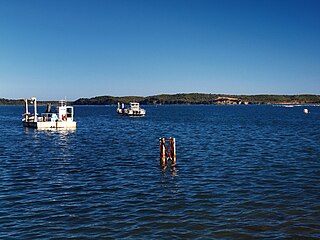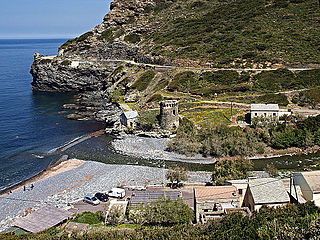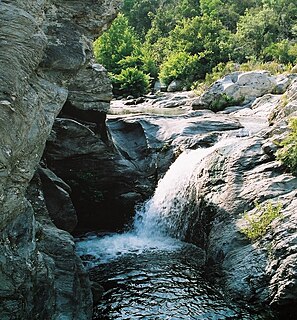Human impacts
In the late 19th century the decline in agriculture led to croplands and pasture being replaced by wild undergrowth and woods, which reduced the amount of erosion and run-off. This in turn led to less sediment being carried to the mouth of the river. In the 1970s in-channel gravel mining began in the river. The gravel pit traps sediment, and has caused braided channels to be replaced by a single channel. An alder forest colonized the gravel pit, trapping most of the sand from the watershed and creating a flood risk. Downstream, the result has been erosion of the beach, which started in the 19th century and is likely to continue for several decades, destroying a tourist attraction.
The area around the mouth of the river has been designated a ZNIEFF covering 44 hectares (110 acres) to the northeast of Camp Raffalli. The area is very vulnerable to damage by tourists and the local population, who have created tracks, paths and parking lots. This has caused deterioration of the environment and landscape, and has disturbed waterbirds during their nesting and migration period.

The Étang de Diane is a coastal lagoon beside the Tyrrhenian Sea on the east coast of Haute-Corse department on the French island of Corsica. The lagoon served as a port for the Ancient Greeks, and then for the Romans. Today it is privately owned and mainly used for shellfish farming and fishing.

The Étang de Crovani is a coastal lagoon beside the Mediterranean Sea on the west coast of the Haute-Corse department on the French island of Corsica.

The Figarella is a small coastal river in the northwest of the department of Haute-Corse, Corsica, France.

The Sisco is a small coastal stream in the department of Haute-Corse, Corsica, France. It enters the Tyrrhenian Sea from the east of the Cap Corse peninsula.

The Oso is a small coastal river in the southeast of the department of Corse-du-Sud, Corsica, France.

The Francolu is a coastal stream in the southeast of the department of Corse-du-Sud, Corsica, France.

The Ese is a river in the department of Corse-du-Sud, Corsica, France. It is a tributary of the Prunelli river, which it joins in the Lac de Tolla.

The Canella is a coastal stream in the south of the department of Corse-du-Sud, Corsica, France. It has ecologically interesting wetlands at its mouth.

The Lava is a coastal stream in the west of the department of Corse-du-Sud, Corsica, France.

The Cruzzini is a river in the center of the department of Corse-du-Sud, Corsica, France. It is a tributary of the river Liamone. The valley is isolated, heavily wooded, and surrounded by high and steep mountains. There is little tourism, and the population is poorer and older than in the island as a whole.

The Porto is a small coastal river in the northwest of the department of Corse-du-Sud, Corsica, France.

The Buggiu or Valdolese, Vughio is a small coastal river in the department of Haute-Corse, Corsica, France. It flows into the Golfe de Saint-Florent in the north of the island. The estuary at its mouth has ecological value.

The Liscu ) is a small coastal river in the north of the department of Haute-Corse, Corsica, France.

The Poggiolo is a small coastal stream in the department of Haute-Corse, Corsica, France. It enters the Tyrrhenian Sea from the east of the Cap Corse peninsula.

The Chiosura is a small coastal stream in the department of Haute-Corse, Corsica, France. It enters the Tyrrhenian Sea from the east of the island.

The Guadu Grande is a small coastal stream in the department of Haute-Corse, Corsica, France. It enters the Mediterranean Sea from the west of the Cap Corse peninsula.

The Olmeta is a small coastal stream in the department of Haute-Corse, Corsica, France. It enters the Mediterranean Sea from the west of the Cap Corse peninsula.

The Varagno is a stream in the department of Haute-Corse, Corsica, France. It is a tributary of the Fiumorbo.

The Saltaruccio is a stream in the department of Haute-Corse, Corsica, France. It is a tributary of the Fiumorbo.

The Col de Marsolino is a mountain pass in the Haute-Corse department of Corsica, France. The pass is in the west of the Monte Cinto massif. It connects Calvi and Calenzana to Galéria. Its low altitude allows it to be open almost all year round.
This page is based on this
Wikipedia article Text is available under the
CC BY-SA 4.0 license; additional terms may apply.
Images, videos and audio are available under their respective licenses.



















